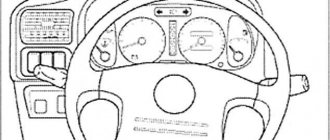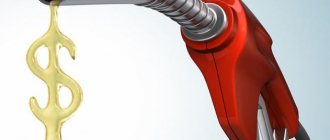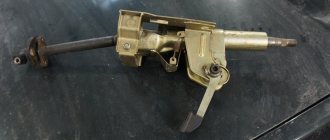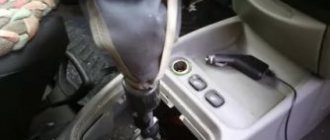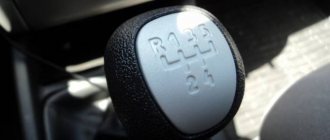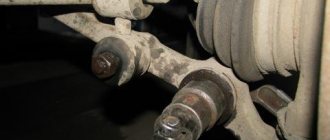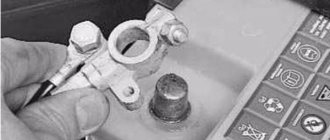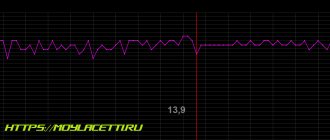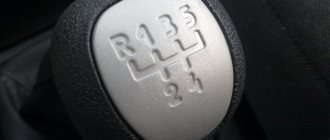Backlash is a term in mechanics that implies the presence of free movement in an element of a mechanical system. It represents a parameter by which one can judge the amount of movement of the node mentioned above to obtain a response from another - the controlled node.
In other words, the amount of backlash is characterized as the amount of rotation or displacement of the controlled element, which does not lead to any changes in the object.
In relation to a car and steering, the angle of rotation of the steering wheel at which the car continues to move in the same direction.
What is meant by total steering wheel play?
Another term that requires consideration is “total backlash.” It refers to the total angle, which starts from the extreme position of the steering wheel on one side when turning begins, to the opposite position when the car starts moving in the other direction.
To understand the principles of operation of the total backlash, it is important to understand the design and operating features of the control system. Based on the technical component, the operating principle of the backlash is as follows.
There is a rod in the transmission of steering rods, which is fixed with a small gap of one or two millimeters.
This distance is necessary to protect the steering system linkages from wear due to excessive friction.
The presence of a gap is a technological solution that allows you to keep the hook in the required position and not touch the surface of the teeth.
For the driver, this parameter represents free movement of the steering wheel, which allows for more precise control of the car and to feel at what moment the direction of movement of the vehicle changes.
Essentially, this is the total distance the steering wheel travels before the car moves to the left or right.
Many people mistakenly consider this phenomenon negative and try to get rid of it. You shouldn’t do this, because play in the steering is the norm for every car. Another thing is that it must have a strictly defined value.
An interesting pattern can be traced here - the larger the car’s dimensions, the higher the backlash indicator.
In the process of measuring the total backlash, a number of conditions must be met:
- The front wheels are located in a neutral position and stand on a hard (asphalt or concrete) surface.
- The steering wheel tires are dry and clean.
- The car engine is started. This is relevant if the operation of the power steering is tested.
- The tension of the power steering pump drive belt, as well as the level of the working fluid, must meet the requirements approved by the manufacturer.
The total play is checked by measuring the angle of rotation of the control wheel between the fixed positions for changing movement to the left and right.
To obtain accurate parameters, measurements are made two or more times.
Look at the topic - Can the traffic police check the technical condition of a car on the road?
The driver is responsible for the technical condition of the vehicle. According to the Rules, every morning, after taking a sip of coffee, the driver, before starting the trip, is obliged to check it for any malfunctions that would prohibit operation. If at least one malfunction is detected, you cannot leave the parking lot.
But what if the problem occurs along the way? Do traffic police officers have the right to check the technical condition of the car, such as steering rack play, condition of brakes, engine and other malfunctions? In what cases can they do this, what will happen for certain malfunctions and when can you go to the parking lot or car service center?
The inspector’s right to check the technical condition – what does the 2021 law say?
The list of these faults for 2021 is contained in two documents:
The second list is broader, the status of the Technical Regulations is higher than the Basic Provisions, and the Technical Regulations were adopted later. Theoretically, both traffic police and drivers should be guided by it regarding the technical condition of the car.
To bring the two documents into compliance, amendments to the traffic rules were prepared 3 years ago, which remain shelved. Knowing the enthusiasm of officials, which awakens exclusively before the New Year, it is quite possible that the relevant amendments will nevertheless be adopted by the end of the year, followed by the adoption of amendments to the Administrative Code.
In the meantime, they are punished only for malfunctions that are mentioned in the Basic Provisions for Admission, except for tinting, the requirements for which are prescribed in the Technical Regulations.
In fact, no one fulfills the indicated duty of checking the play of the steering wheel, the serviceability of the engine, and the brakes of their car in the morning - there is a widespread violation of traffic rules.
On the one hand, this is impossible. For example, how do you check that the parking brake is holding a vehicle with a full load on a 16% grade? Every morning, look for a 16% slope, load the car with sandbags, pull the handbrake and see: will the car roll or not? Or buy a brake testing stand?
When can and when can they not check for faults?
Traffic police inspectors have a rather cool attitude towards monitoring the technical condition of a car.
The thing is that there is no clear description of the procedure, and the inspector can only improvise, disguising his actions, which supposedly comply with the law.
In full accordance with the Administrative Regulations of the Traffic Police, an inspector can stop a driver in 4 cases:
If the inspector sees a malfunction after stopping, for example, to check documents, he can also check the technical condition of the car. And here I would like to draw your attention: if the car was not involved in an accident, there are no orientations and no measures are taken, then the inspector does not have the right to take any action to detect malfunctions. For example, the driver cannot be required to turn on the rear fog light to check whether it works or not.
Should I open the hood, roll up the window and participate in the inspection?
No. The driver has no obligation to participate in the technical condition check.
To determine the procedure for checking the technical condition, corresponding administrative regulations have been developed. Like any other regulation, it must contain the rights and obligations of persons in respect of whom control (supervision) measures are carried out, naturally established by law. But these regulations do not specify any responsibilities of drivers.
However, the Supreme Court in certain situations takes the side of traffic police inspectors. For example, for refusing to raise the driver's side window to check its light transmission, the driver was charged under Part 1 of Article 19.4 of the Code of Administrative Offenses for disobedience to an official's order. However, since then new regulations have been adopted, and it is quite possible that in 2021 the Supreme Court would hardly have made such a decision.
What will the inspector do if a fault is found?
He will charge the driver under Part 1 of Article 12.5 of the Code of Administrative Offenses with a fine of 500 rubles, and he will be released on all fours, since the malfunction was discovered on the way. But this approach of inspectors to punishment for malfunctions does not meet the requirements of the law.
Permissible backlash in cars
The traffic regulations stipulate normalized indicators of total play for various cars. In addition, this parameter should not exceed the figures specified in the documentation for the operation of the machine.
If there are no special recommendations in the manufacturer’s papers, the backlash should be as follows:
- For passenger cars, as well as bus and truck components made on their basis - 100;
- For buses - 200;
- For trucks - 250.
There are also separate recommendations for some models:
- For VAZ-2106, 2107, 2110, 21213 - 50;
- For Gazelle 3302 - 200 (passenger version) and 250 (truck).
Tolerance
As we have already said, automakers set the permissible amount of play. It is usually 2-3 millimeters, or degrees of slope. They are necessary so that the control mechanisms are not under constant pressure and, accordingly, last longer due to less wear.
The norm is prescribed in the technical documentation, but it may be different for different vehicles. Usually for buses and trucks it is slightly higher, again, due to the greater load on the steering rack. For passenger cars it is limited to a couple of degrees.
Reasons for large backlash
The increase in play can be explained by changes in the design features of the steering, as well as the destruction of their elements.
The main reasons include:
- Worn gear bar and steering rack gear teeth.
- Damage or deformation of the wheel bearing. There are cases when it falls apart during operation, which leads to an increase in backlash (but there will be no time for backlash).
- Malfunction of tips and tie rods, which often break if operating requirements are not followed. The result is the same as in the previous case - “looseness” of the steering wheel.
- Poor quality repair of the vehicle chassis. There are situations when steering play manifests itself after visiting a service station. This is possible when service technicians do not tighten the wheel bearing nut sufficiently. As a result, the car's steering system suffers.
- Breakage of the ball joint (lower or upper), as well as pulling the steering rack with excessive force.
- Outdated hydraulic oil that requires replacement. Often play in the steering is eliminated after filling with new working fluid.
Generally speaking, play occurs when there is a fault in the chain between the steering wheel and the wheels.
To find out the reason, you need to go through the entire chain and identify the “weak” points. The main thing is to make sure that we are talking about increased free play, and not about other problems.
Other causes of play in the steering include:
- Wear or incorrect adjustment of the engagement of the “worm” and the roller mechanism.
- Worn swing arm axle or bushings.
- Loose crankcase fasteners.
Signs of breakdown
As noted above, in order to effectively eliminate a malfunction, it must be diagnosed in a timely manner. To do this, it is enough to know the signs of play in the steering.
The main symptoms include:
- The appearance of a knock in the steering mechanism;
- Increased vibrations while driving;
- Creaking when turning wheels;
- Deviation from a given trajectory when the steering wheel is in a straight position.
When adjusting the steering play, you should take into account the manufacturer’s recommendations and traffic rules.
The configured parameter should not exceed the upper limit, but you should not underestimate the indicator either.
Too little steering wheel play can lead to additional discomfort and poor vehicle controllability.
At the same time, you should not ignore the appearance of a small backlash, because over time this parameter may increase, and then it will be more difficult to deal with the problem.
And it’s inconvenient to drive a car when you constantly have to “catch the road” and turn the steering wheel in one direction or the other.
Also read about the causes of knocking when turning the steering wheel.
Diagnosis of the problem and instruments used
To determine whether the parameter corresponds to the norm, you need to do a small check.
To make sure there is a problem, you can use a special device - a backlash meter.
With its help you can check the total (total) play in the system.
One of the device options is K 524 M or ISL-M, which can be used by ordinary car owners and professionals at service stations.
Using a backlash meter, it is possible to determine the amount of free play in just three minutes, including taking into account installation and removal of the device.
The algorithm for diagnosing steering play is as follows:
- Start the engine (it should be idling);
- Place the front wheels parallel to the longitudinal axis of the machine. At the same time, make sure that the hydraulic booster is working;
- Turn the steering wheel one way and then the other. At this moment, record the moments when the front wheels begin to scroll in the required direction. The distance that the steering wheel travels between these intervals is called play (free play).
This check is considered an excellent option for drivers who need accurate and quick information.
It does not matter how the problem was diagnosed. If the steering play exceeds the norm, it must be eliminated.
How to diagnose a malfunction?
Steering play is especially pronounced when driving on a straight road at high speed. A sign of a breakdown is a knocking sound when the steering wheel is turned sharply. An increasing knocking sound while driving on uneven terrain indicates damage to the steering ends and rods. Knocking into the steering wheel indicates a faulty steering bar.
If the steering wheel “beats” when driving, this indicates a failure of the ball joint or steering ends. The cause may also be wear of the bushing, bearing, or crosspiece.
A noise of unknown origin when turning the steering wheel indicates the need to check the fluid level.
A change in the given direction of movement of the car with the steering wheel in a straight position, the feeling that the car is “pulling” to the side, indicates an unbalanced camber - wheel toe-in.
The steering wheel turns jerkily if the steering bar is jammed. If it turns with force, you need to check the operation of the amplifier.
To find out if there are problems with the steering, you should do a small check:
To more accurately determine the gap, use a special backlash meter.
